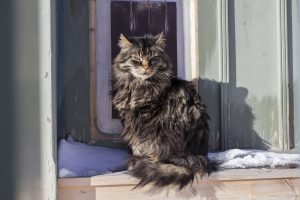My cat has cold ears and I want to know why…
Many pet parents wonder why their cat has cold ears and worry about them. Basically, it is normal for body temperature to be slightly lower in exposed areas such as the ears than in the rest of the body. The reason for this is the lower blood circulation of the peripheral parts of the body in relation to the surface. In addition, the ears are barely hairy, very thin and have little fat subcutaneous and thus more susceptible to cold.

As a cat owner, it is important to be able to differentiate when cool or cold ears reflect a physiological, that is normal for the body, or are a symptom of a serious illness. Here are five reasons why your velvet paw has cold ears:
-
Thermoregulation (maintenance of core body temperature)

Cats that go out in the snow are likely to return home cold
Among other things, cats can use their ears to regulate body temperature. If your cat is cold, the circulation in the ears is reduced to preserve the heat for the vital internal organs. Your cat may simply just have cold ears due to being out in cold temperatures such as when snow is falling. If this is the case you don’t need to worry. With a warm cookie and a gentle ear massage, you can quickly bring your tiger back to operating temperature.
-
Mild perfusion (reduced blood flow) during periods of rest
Another possible cause of cool cat ears may be a behavioural reduction of blood flow around the body (appendages). The
metabolism and thus the heat production are reduced, especially during sleep and during rest periods. This saves body power and energy for a later time. If no additional behavioural changes or disease symptoms occur, cool ears at such moments are not a cause for concern.
-
Hypothermia
Hypothermia (lowering of the body temperature to less than 36 ° C) occurs when the heat absorption and production in relation to the heat release over a longer period of time are too low. This leads to failure of thermoregulation due to extreme drops in body temperature. There are a few circumstances that encourage hypothermia. For example, if your cat is exposed to low temperatures for too long with wet fur. Also if there is a constant draft in your cat’s favourite chill spot this could play a role.
In case of hypothermia – your cat has cold ears as well as paws, tail and mouth. The best way to feel this is with the back of your hand. In this case, you should warm your cat immediately by wrapping them in a blanket together with a hot water bottle (not too hot and not directly on the skin!) And seek veterinary advice as soon as possible. Left untreated, hypothermia can cause tremors, lethargy, convulsions, and loss of consciousness or even death.
-
 Frostbite
Frostbite
Local frostbite is not just hypothermia, but actual freezing of the tissue, either directly through crystal formation or indirectly through circulatory disorders. Especially peripheral parts of the body, such as the tips of the ears, can become conglutinated with prolonged extreme cold. In frostbite, your cat’s ear tissue is not only cold, it also has other symptoms such as pale grey or bluish skin discoloration, pain on touch, swelling, blisters, and possibly blackening in the affected area. If your cat’s ears are affected, your protégé needs immediate veterinary attention. As a first aid, you can warm his ears with warm (not hot!) water.
-
Serious diseases
If only your cat’s ears feel cool and your pet behaves normally, that’s a normal reaction to the environment. However, if your cat has symptoms other than cold ears it may be a sign of a serious illness. Symptoms such as apathy,
vomiting or respiratory distress may insinuate shock, poisoning or cardiac problems. In this case, it is essential to see a vet immediately for assistance and to determine the cause of the disease.
 As a cat owner, it is important to be able to differentiate when cool or cold ears reflect a physiological, that is normal for the body, or are a symptom of a serious illness. Here are five reasons why your velvet paw has cold ears:
As a cat owner, it is important to be able to differentiate when cool or cold ears reflect a physiological, that is normal for the body, or are a symptom of a serious illness. Here are five reasons why your velvet paw has cold ears:

 Frostbite
Frostbite
